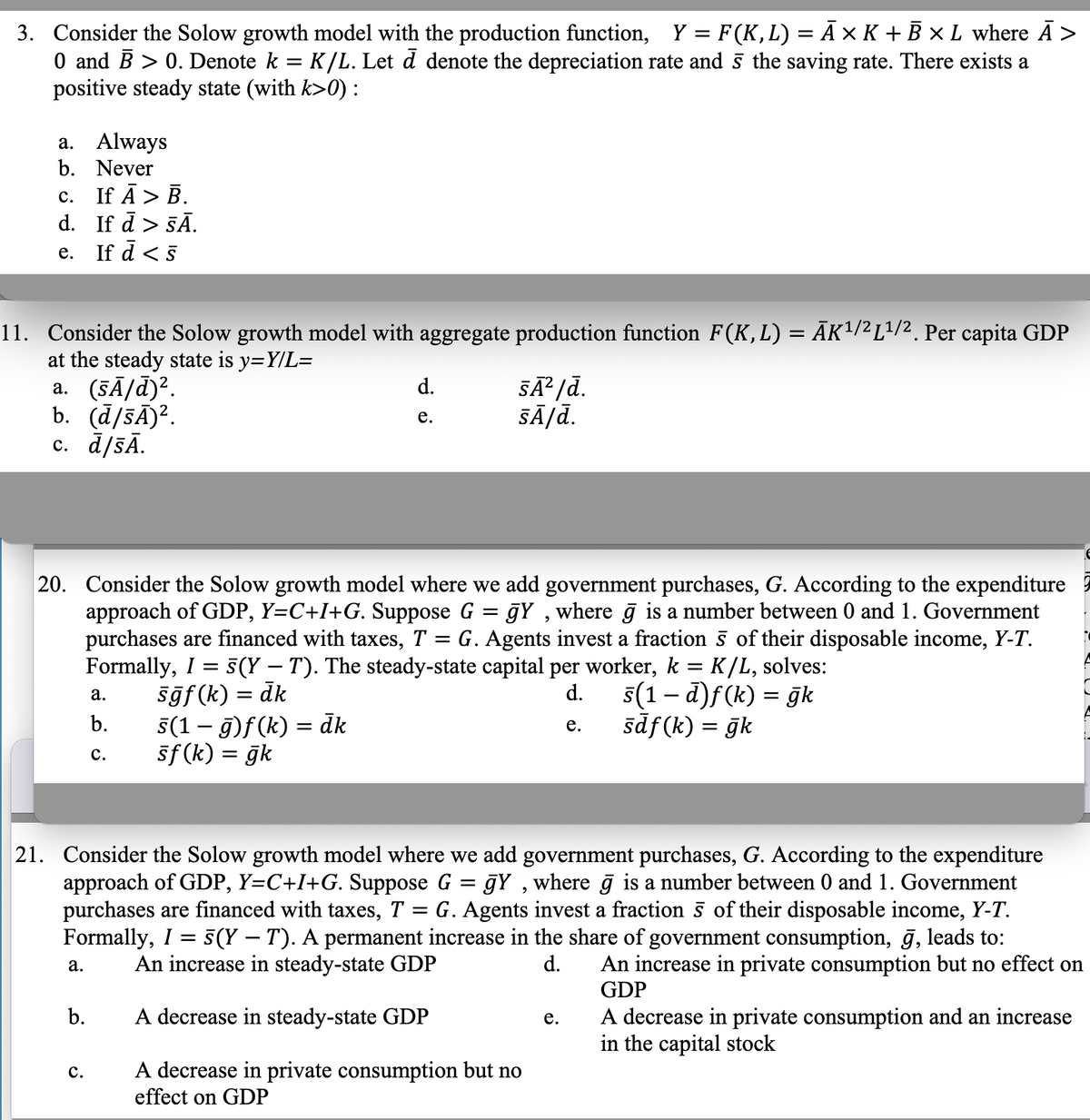. Consider the Solow growth model where we add government purchases, G. According to the expenditure approach of GDP, Y=C+I+G. Suppose G = gY, where ģ is a number between 0 and 1. Government purchases are financed with taxes, T = G. Agents invest a fraction 5 of their disposable income, Y-T. Formally, I = 5(Y – T). The steady-state capital per worker, k = K/L, solves: sgf(k)= dk d. s(1 − d)ƒ (k) = ģk e. sdf (k)=gk a. b. C. s(1 − ģ)ƒ (k) = dk sf (k)= gk
. Consider the Solow growth model where we add government purchases, G. According to the expenditure approach of GDP, Y=C+I+G. Suppose G = gY, where ģ is a number between 0 and 1. Government purchases are financed with taxes, T = G. Agents invest a fraction 5 of their disposable income, Y-T. Formally, I = 5(Y – T). The steady-state capital per worker, k = K/L, solves: sgf(k)= dk d. s(1 − d)ƒ (k) = ģk e. sdf (k)=gk a. b. C. s(1 − ģ)ƒ (k) = dk sf (k)= gk
Chapter20: Economic Growth In The Global Economy
Section: Chapter Questions
Problem 5P
Related questions
Question
I need help with 20 with justification

Transcribed Image Text:3. Consider the Solow growth model with the production function, Y = F(K, L) = Ā× K + B × L where à >
0 and B > 0. Denote k = K/L. Let à denote the depreciation rate and 5 the saving rate. There exists a
positive steady state (with k>0):
a. Always
Never
b.
c. If Ā > B.
d.
If d > šĀ.
e. If d < 5
11. Consider the Solow growth model with aggregate production function F(K, L) = ĀK¹/² L¹/2. Per capita GDP
at the steady state is y=Y/L=
a. (sÃ/d)².
b. (d/sÃ)².
c. d/sÃ.
20. Consider the Solow growth model where we add government purchases, G. According to the expenditure
approach of GDP, Y=C+I+G. Suppose G = gY, where is a number between 0 and 1. Government
purchases are financed with taxes, T = G. Agents invest a fraction 5 of their disposable income, Y-T.
Formally, I = 5(Y – T). The steady-state capital per worker, k = K/L, solves:
sgf (k)= dk
d.
s(1 - d)f(k) = gk
sdf (k) = gk
e.
a.
b.
a.
b.
C.
C.
d.
e.
š(1 − g)ƒ (k) = dk
sf (k) = gk
21. Consider the Solow growth model where we add government purchases, G. According to the expenditure
approach of GDP, Y=C+I+G. Suppose G = gY, where is a number between 0 and 1. Government
purchases are financed with taxes, T = G. Agents invest a fraction 5 of their disposable income, Y-T.
Formally, I = 5(Y – T). A permanent increase in the share of government consumption, ā, leads to:
An increase in steady-state GDP
d. An increase in private consumption but no effect on
GDP
A decrease in steady-state GDP
A decrease in private consumption but no
effect on GDP
SA²/d.
SÃ/d.
e.
A decrease in private consumption and an increase
in the capital stock
Expert Solution
This question has been solved!
Explore an expertly crafted, step-by-step solution for a thorough understanding of key concepts.
This is a popular solution!
Trending now
This is a popular solution!
Step by step
Solved in 2 steps with 1 images

Knowledge Booster
Learn more about
Need a deep-dive on the concept behind this application? Look no further. Learn more about this topic, economics and related others by exploring similar questions and additional content below.Recommended textbooks for you

Exploring Economics
Economics
ISBN:
9781544336329
Author:
Robert L. Sexton
Publisher:
SAGE Publications, Inc

Exploring Economics
Economics
ISBN:
9781544336329
Author:
Robert L. Sexton
Publisher:
SAGE Publications, Inc